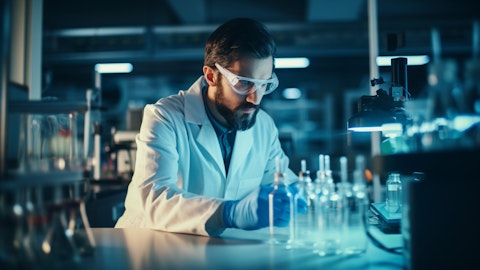And when you think about not just CD3, but the other side of engaging the tumor, there are multiple targets where even finding a good binder or certainly a diversity of binders can be difficult. And so that, coupled with the bi-specific engineering, provides a complete solution to this problem that we intend to show will be a validated solution in the clinic. Of course, that’s going to take some time. Now, your other question was, of the programs that you’ve shown, how are you going to decide which ones to bring forward? I mean, the short answer is that it’s a combination of commercial considerations, meaning competition, as well as primarily the science. So we have, to date, started five different programs in oncology. We’ve also started a program in autoimmunity.
At this point there’s two of the programs in oncology that we’re not going to be bringing forward. The other ones we are bringing forward into animal studies. And then we’re going to need to make a decision based on the results we have, based on the data, based on what’s happening out in the field, and based on what we think the biggest opportunity is. And then, of course, weighing that up against some of the other programs that we have coming from other platforms, such as the GPCRs & Ion Channel platform.
Unidentified Analyst: Great. Thank you so much.
Operator: Our next question today is from the line of Jacqueline Kisa of TD Securities. Please go ahead. Your line is open.
Jacqueline Kisa: Hi, this is Jacqueline Kisa on for Steven Mah. Thanks so much for taking the questions. Just to start, on the Viking ArrowMark new co-structure, do you maintain any equity ownership and could you describe what happens if the new co gets acquired?
Andrew Booth: Yes, it’s Andrew. Happy to take that Jacqueline. So the partnership we have with ArrowMark is at first a discovery partnership where we will work with them in order to find the antibodies against targets that they elect. They would then go into new co where we would have founding equity in those companies. And then we would — ArrowMark and Viking would fundraise independently around those in order to advance them further towards the clinic. We would then be a regular equity holder and it’s in a very similar fashion that we have done the deal with Abdera. I also would note that Viking was one of the equity participants in the transaction, the series be announced by Abdera. So it’s a very similar structure to that deal.
Jacqueline Kisa: Great. Thank you. And then, just with regards to your GMP Biologic Manufacturing Facility, are there any changes to the timing of that development and has that downstream capability that’s been created impacted your partnership discussions?
Andrew Booth: Yes, I think there have been no recent changes to the timing there. Just as we said in the full year earnings call a few months ago, we’re expecting our first engineering batches in 2025, and Carl reiterated that today in prepared remarks. With regards to the interest from partners, I think certainly in our co-development programs, the transaction and partnership you just mentioned, there are of course interest in those capabilities, and those capabilities would be on time online in around the right time for when those molecules might be advancing through to IND Enabling studies. So I think that those really marry up very well with each other.
Jacqueline Kisa: Excellent. And then if I could just sneak one more in, just on your Biogen partnership, are you getting any more traction with the Camelid antibodies, and how does that interest compare to the other offerings that you have?
Carl Hansen: Carl here. So I’m not sure exactly what you’re referring to in the Camelid antibodies for the Biogen deal. So the Biogen deal is exciting for two reasons. One, we have an opportunity to work with a new partner that’s one of the heavy weights in the space. So we’re excited about that as the start of a relationship that we hope will be able to grow over time. And secondly, the program is focused on being able to solve what is one of the really huge problems in biologics, which is being able to efficiently transport antibodies and other types of biologics across the blood brain barrier. So we’re going at that based on a lot of groundwork by Biogen. And we think it’s an exciting program. It’s at the very early stages. But if successful, we think that that could make a big difference, not just for Biogen, but for the field.
Jacqueline Kisa: Great. Thank you. I appreciate it.
Operator: Our next question today is from the line of Scott Schoenhaus of KeyBanc. Please go ahead. Your line is open.
Scott Schoenhaus: Hi, team. Most of my questions have been asked, but I just wanted to touch on the three additional partner initiated programs. Can you just give us more color on the partners themselves, kind of therapies you’re engaging with on these new programs? Just broad color if you could provide it. That’s my first question. Thanks.
Andrew Booth: Hey, Scott, I think the three, we don’t normally disclose the details about the programs, that’s a partner initiation, but what we do is on an annual basis, you can find it in our full year results, show kind of a broadly across the number of programs we started, how they’re distributed through different therapeutic areas. And what we started in the first quarter is really tracks really closely to what we have seen in the past.
Scott Schoenhaus: Okay, great. I know it’s hard to give specifics on that. I guess my follow-up question would be on the internal molecule, the ABCL635. Do you still plan to take that through phase two on its own? And that’s it for me. Thanks.
Carl Hansen: Thanks, Scott. Carl here. I’ll take that one. So 635, just remind everyone, is an internal program against the GPCR & Ion Channel target for an indication in metabolic and endocrine disorders. It’s one that we believe has the potential to be a first-in-class therapy and a program for which we’re very excited. For strategic reasons, we have not disclosed any more than I just recounted here. In terms of our plans for clinical development, at this point, we’re focused on getting this one to the start line in clinical development. We do believe that the nature of this program means that we’ll get a lot of information in terms of proof-of-concept and safety from the early trials. And if those look good, then I think there’s a real path for us taking this molecule further. But we’re not committing to that until we see the data and we see where we are as a company at that point.
Scott Schoenhaus: Thank you.
Operator: Our next question today is from the line of Stephen Willey of Stifel. Please go ahead. Your line is open.
Stephen Willey: Yes, good afternoon. Thanks for taking the questions. Maybe just a follow-up on the TCE line of questioning. So, I know you spoke about having optimism regarding being able to make a deal that provides access to the platform, but it also sounds like such deal would probably require you to carve out some targets for internal development. So is the translational work that you’re hoping to complete the in-vivo work, is that rate limiting at all to your ability to get a broader platform deal done?




